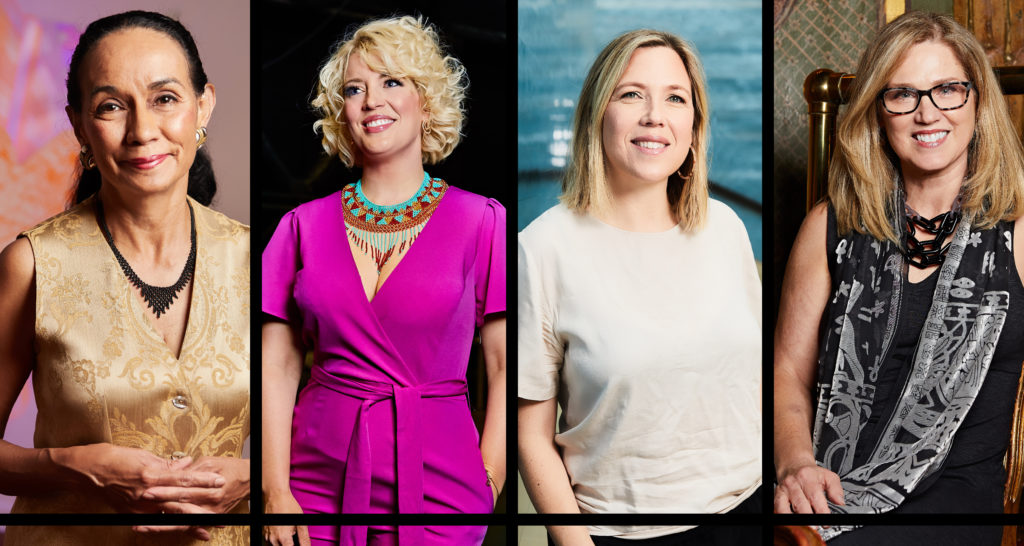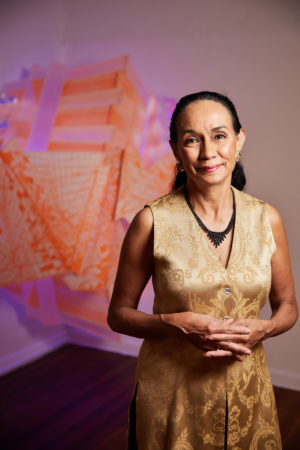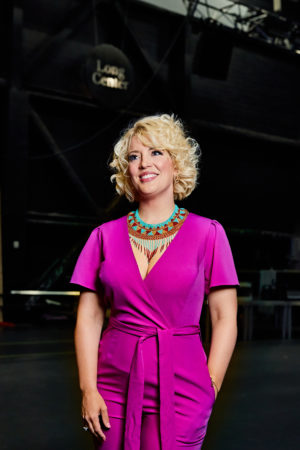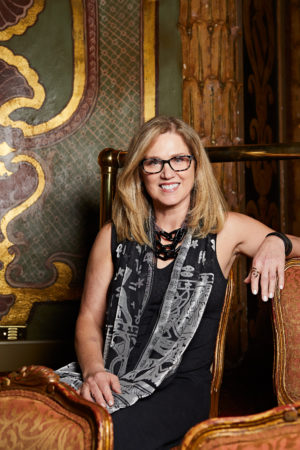From highlighting contemporary works and unforgettable vocal displays to growing a museum that preserves the history and crafts of Latin cultures to creating a skyrocketing local comedy festival, four women commanding Austin’s flourishing creative scene are proving they have it all down to a fine art.
By Nicholas Barancyk, Photos by Annie Ray

Sylvia Orozco Co-founder of Mexic-Arte Museum
Humans have obsessed about their origin for thousands of years. It’s a natural question to wonder where we came from and how we got here. Nowhere is this idea exemplified more than in museums, where art and artifacts are carefully documented, catalogued and preserved so some insight can be gleaned by future generations.
However, much of history as it’s taught in the West has been dominated by a single perspective. It’s told through the lens of colonizers and conquerors, with minor regard for those who have been subjugated. This lack of totality is what drove Sylvia Orozco to co-found Mexic-Arte Museum in the early 1980s, so the stories of Latin peoples could be safeguarded against the rigors of time.
Organizing galleries has been a lifelong pursuit for Orozco, even when she didn’t realize she was doing it. Growing up in her hometown of Cuero, Texas, there wasn’t much in the way of a museum. So, she made her own. Gathering twigs, leaves and rocks, she’d assemble micro installations in small boxes.
 “I didn’t know I was making collections,” she says, “but that’s what I was doing on my own.”
“I didn’t know I was making collections,” she says, “but that’s what I was doing on my own.”
As she grew, this affinity for arranging curiosities would push her to study painting at the University of Texas, earn her master’s degree at the Academy of San Carlos—the oldest art academy in North America—and eventually create Mexic-Arte with fellow artists Sam Coronado and Pio Pulido.
In the beginning, Orozco only showcased Mexican art, incorporating dance, theater, music and visual art. But as the years progressed, she condensed her approach and broadened her breadth. Mexic-Arte expanded to include all Mexican, Latino and Chicano art, joining the small handful of museums throughout the country dedicated to Latin art.
In the art world, context begets appreciation. Orozco compares understanding art with understanding a novel: The more books you read, the better grasp you’ll have on how language is constructed, thus strengthening overall competency.
“I think most people don’t realize that art is a visual language,” Orozco says.
Context is especially important for museums like Mexic-Arte, which strives to illuminate issues unrepresented or glazed over in Western polish. To fully appreciate the complexity of issues at sake, it is crucial to hear narratives from every side.
“We’re saying something with just lines or dots or planes,” Orozco says.
Currently, the museum is focusing on themes of immigration and conflict at the border. The latest exhibition, Beyond Walls, Between Gates, Under Bridges, is comprised of photographic images and new media showcasing scenes of protest and resistance, particularly resistance to the loss of one’s culture.
For Orozco, museums are more than just repositories for creative works. They’re cultural lexicons that inform us of a society, how it used to work and how it works today.
“Art documents a culture,” she says. “It’s a written or painted or sculpted record of the time.”
When people move, their traditions follow, commingling with other cultures to create multifaceted societies full of depth and diversity. So, if we’re to understand how they got here, we must learn to read their past from every perspective.
Mexic-Arte Museum: Check out Mexic-Arte’s 35th annual Viva la Vida Festival and Parade Oct. 27. Austin’s largest and longest-running Day of the Dead celebration includes a parade, floats and live music. Admission is free all day.
Mela Sarajane Dailey Soprano and Co-producer of Mass 
Life is a joy ride for vocal chameleon Mela Sarajane Dailey. With a background in pop, jazz and gospel music, Dailey began her love affair with classical performance in high school, 25 years ago. Since then, she’s sung in countless venues, performed with numerous symphonies and even earned a Grammy Award with choral group Conspirare.
One of her most glowing accomplishments of late is co-producing and performing in the Austin rendition of Leonard Bernstein’s celebrated musical-theater composition Mass.
“That was one of the most memorable experiences of my life,” Dailey says. “It’s surreal when you see it. All of that two-and-a-half-plus years of day-in, day-out. … We were just happy we got to do it. We didn’t know it would mean this much. I think this piece touched on a lot. I think it touched on our need for community, our need to believe in something bigger than ourselves, our need to see people decide that they can work together and that working together is more important than anybody’s ego.”
Perhaps best known for her work with Conspirare, which regularly engages audiences in a way that’s tantamount to musical magic, Dailey, also the wife of lauded Austin Symphony Orchestra Music Director and Conductor Peter Bay, is a skilled virtuoso in several musical genres, but this Grammy Award winner insists classical music is still relevant in today’s technology-fueled music industry.
“There’s so many levels to [classical music],” Dailey says. “I can appreciate a pop song, and I can hear it and I can get something out of it, but every time I see an opera or go to the symphony, I need it, I crave it because I crave the many layers that I can peel back. It opens up a certain part of your brain and understanding that’s bigger. It’s almost like it widens the lens. And once you’ve widened that lens, the whole world is different.”
Indeed, Dailey notes that as she’s gathered more experience in her musical career and classical study, she’s felt freer to express herself, to “paint with more colors” and tap more tools in her musical toolkit. At the same time, classical music demands more of her, which, in turn, makes her more efficient, more ambitious and a better musical “athlete.”
And athletic is a good way to describe many of the grueling tasks Dailey undertakes in her effort to be her best. When it comes to preparing for a concert or lengthy opera, she approaches the endeavor in focused segments.
“Whether it’s a pop song or a full three-hour opera, I always just start with the words. I have to understand who the person is first before I even try to touch the music,” she says. “For a three-hour opera, that’s a long process and it’s worth it. It’s like the reward you get for spending a lot of time with a character.”
In terms of what Dailey strives to understand about such characters, she notes the key component is having a good grasp of the characters’ humanity.
“Even if it’s a character that’s a villain, let’s say, I want to understand their ‘why.’ If I understand their why, then I can understand their humanity, and if I understand their humanity,” she says, “then it will come off the page. The deeper the character is, the more satisfying and enjoyable it is.”
Of course, as Dailey well knows, a vocal instrument can be a lot more difficult to maintain than any other musical instrument, by virtue of its human limitations. She approaches her voice as an instrument that’s constantly evolving.
“That’s the difference between being a singer and every other musician,” she says. “We get this one instrument that evolves and changes, so you’re constantly relearning that instrument. The good news is that all your work starts to pay off. All your education foundation, your toolkit, is getting better and better at the same time your actual instrument is getting better and better. Vocalists don’t really hit their stride until [they’re] 45.”
But she also admits to having a keen understanding of the time limits inherent in being a vocal star. Still, she’s perfectly happy to embrace the career she has while looking forward to the future.
“Unlike a pianist, where you can play forever, there’s a time limit. And it forces you to be very appreciative of everything you have because there’s a time it won’t be there. And that’s something that every professional vocalist has to wrestle with. I will be grateful in any way I can express vocally for as long as I can,” Dailey says. “There are so many operas and oratorios that I had no business singing in my 20s, but you’re drawn to it because it’s so beautiful. But I didn’t have a clue of the depth of expression that’s needed, and also just the physicality. But I sang the Verdi Requiem with the Austin Symphony. … If I could sing that forever, I would sign up and do it every month.”
Conspirare: Mela Sarajane Dailey will tour with Conspirare this fall on Artistic Director Craig Hella Johnson’s new show, Considering Matthew Shepard, dedicated to the 20th anniversary of the young man’s death.
 Veronica Roberts Curator of Modern and Contemporary Art at Blanton Museum of Art
Veronica Roberts Curator of Modern and Contemporary Art at Blanton Museum of Art
Veronica Roberts had her doubts about contemporary art. She first encountered the movement during a class field trip to Los Angeles, where a piece by artist Felix Gonzalez-Torres left her puzzled. Gonzalez-Torres was Cuban-born, openly gay and creating at the height of the AIDS epidemic. He showcased a stripped-down aesthetic and used everyday items like beads and stacks of paper to realize his vision.
But Roberts couldn’t wrap her head around how a pile of candy he had created could be considered art. People were grabbing pieces from the pile, undressing the tiny packets of hardened sugar and popping them in their mouths. She followed suit, peeling off the plastic membranes and chomping down. Then she noticed the artwork’s title: “Untitled (t-cell count).” She was riveted.
“I realized what power art can have,” Roberts says.
Along with her own grandmother, Gonzalez-Torres would continue to be a major inspiration for Roberts as Shem worked her way through an art-history master’s degree and subsequent associate curator roles. She’d eventually land the job, in 2013, as the curator of modern and contemporary art at Austin’s beloved Blanton Museum of Art, where she’s just as excited as ever to share art with Austinites.
Roberts was never interested in curating to a small set of peers. Instead, she considers herself more of an educator, translating the complicated ideas of contemporary art for a more general audience.
“I’m always thinking about how we can make art more relevant,” she says, “how we can bring more people under the tent.”
But this can be a struggle in the heart of Texas, where there’s not a cultural history of fine-art galleries like there is in other metropolitan locales like New York City and Pittsburgh. Roberts sees it as a welcome challenge made more satisfying by the Austin community.
“This city is a place where people are filled with intellectual curiosity,” Roberts says.
With her audience driving inspiration, she’s unburdened from the pressures of the art community at large in favor of highlighting fresher perspectives.
“I’m interested in the blind spots of art history in particular,” she says, noting a specific interest in friendships between artists.
Roberts says too often, artists are pitted against each other “like a boxing match” during shows, that scholarship exemplifies rivalries but forgets artists’ humanity, where friendships are as influential to their work as competition. This myth is what Roberts is combatting.
“We’ve inherited [it]and it’s made the art world harder to be understood,” she says.
At its worst, Roberts admits contemporary art can go a little overboard. Pieces may become overly conceptual, their prices astronomically inflated and their creators and critics insisting the average Joe just doesn’t “get it.”
“I sympathize with people who feel that contemporary art is trying to make you feel dumb,” Roberts says. But she explains that is just a small subset of the movement because at its best, it can act as a portal or “an entry point for dealing with some of the complexities of our world…and [a way] to see those situations more clearly or critically.”
When modern-day art is good, it can reveal new facets of old conversations and tackle tragedy with grace.
“One of the things that I find thrilling about contemporary art is the way it responds to the world now,” Roberts says. “It feels constantly relevant to the lives that we lead and the world that we’re part of.”
The types of shows Roberts likes to organize are those that penetrate, those that stretch into our reptilian brains and tinker with our physiology, pausing the air in our lungs or manipulating our heartbeats. And she doesn’t achieve this through blockbuster showings of Vincent van Gogh or Henri Matisse, but through the untold stories of great creators, wherein a new element about their life is illuminated.
“Those moments where you can combine scholarship and new ideas with something that can have emotional resonance,” Roberts says, “really get me excited.”
Contemporary and modern artworks, like people, are complex. They’re abstract. They’re not always easy to digest and it takes time for them to marinate in the mind. In this process of slow osmosis, ideas gradually assume shape, color, texture. These snippets of thought are fodder for crucial discourse about our lived realities and inherent humanity. These are the challenging conversations Roberts wants to inspire, restoring vision to our blind spots.
Blanton Museum of Art: Don’t miss current Blanton exhibition The City by native Texan Vincent Valdez. The artist explores the Ku Klux Klan as a modern-day entity. The show runs through Oct. 28. Museum admission is $12.
Lietza Brass Chief Programming Officer at the Paramount Theatre 
What do Orson Welles, Harry Houdini and Barack Obama have in common? As Lietza Brass notes, each has graced the stage of Austin’s own Paramount Theatre. After 14 years as the theater’s executive director of programming, Brass is taking Austin’s century-old entertainment staple to new heights.
After nine years at the Old Globe Theatre in San Diego, Brass, a University of Texas grad, was beckoned back to the city of her alma mater. When she assumed the role of the Paramount’s event manager in 2002,she reached for a yearly goal of 40 shows—a massive number by her account—which consisted mostly of musical theater at the time.
Soon after, the then executive programming director began teaching her the secret arts of booking.
“Learning how to put in offers and book shows is kind of a black-book career,” Brass says, something akin more to art than administration. “Everybody thinks they know how to do it instinctively.”
They’re wrong, most of the time anyway.
Brass wanted to orchestrate a different sort of season after she took over in 2004. She moved from variety, performing-arts-style shows to more genre-based programming. In the legends genre, she brought in Don Rickles and Bob Newhart, while Gladys Knight and Diane Keaton rounded out the theater’s collection of women-focused shows.
“As social media became more and more how we promoted our shows,” she says, “the kinds of shows evolved again.”
This recrafting, refocusing and retargeting is one of Brass’ core methodologies for booking relevant performances in Austin, and it’s been one of the ways she’s grown the theater’s calendar to include more than 200 shows per year.
Today, the Paramount features everything from blues concerts to lectures about astrophysics. But very early on, Brass took note of the intimate stage, neoclassical revivalist architecture and the way the balcony stretched as close as possible to the action. It was a prime biome for comedy.
“Comedians naturally gravitate towards a stage that has beautiful surroundings,” Brass says.
The warm colors and classic elegance of the interior promote a more fluid exchange between performer and spectator. Brass says this has a transformative effect on the talent, observing that when he or she steps onstage, “the artist will rise to the occasion themselves.”
Working off her success assembling comedy shows, Brass aspired for bigger and better.
“The one festival that was not being served in this town, which was basically developing a festival-based economy, was a really high-level comedy festival,” she says.
So, in 2012, she teamed up with Rich Miller and Colleen McGarr of Cap City Comedy Club to create the very first Moontower Comedy & Oddity Festival.
Cap City fronted the club connections, while Brass brought the logistical know-how. She says Moontower was a hit from the beginning and has only grown in popularity since. Her favorite part about the whole shebang is overhearing patrons, gathering what she calls “secret feedback.”
Despite spanning 14 venues, Brass says the event has grown by only 5,000 or 6,000 participants since it started. But this is intentional.
“Instead of growing the footprint of it, [we’re] growing the dimension of it,” she says.
This extra dimension is the festival’s virtual presence online, which includes such popular elements as Netflix’s live shooting of David Cross’ comedy special. This way, it reaches audiences far larger than any of the city’s venues could allow.
“We’re going for worldwide domination,” Brass jokes.
There’s an intimacy to live performance that refuses to be captured by any recording. It’s a quality Brass describes as a system of give and take in which the artist is “giving it all and the audience gives it right back to them, and it’s this wonderful symbiotic relationship.”
Although she’s plotting at online supremacy, Brass notes the physicality of seeing a show in a venue where so many others have sat before, laughing as you laugh, crying as you cry, creates a moment of unity that cannot be replaced.
“When you’re out in a room together and experiencing something as one,” she says, “there’s a sense of camaraderie and community that you’re just not going to get at home.”
For its entertainers and spectators, the Paramount is more than just a building. It’s a chance to pause the complexities whirling through life and, if only for an hour, add another voice to its hallowed golden walls.
The Paramount Theatre: Catch Ira Glass at the Paramount Theatre Dec. 8 for an evening with one of NPR’s most influential radio producers. Tickets start at $35.

